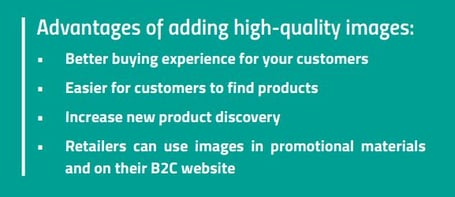People shop with their eyes and images help to reaffirm the customer about the product they are looking to order. This is thoroughly understood in retail, but equally applies to wholesale purchasers as well. Just because retailers know what the plant should look like doesn't mean they don’t want to see an image of it. OrderEase has surveyed hundreds of wholesale buyers on their ordering experience, and those who order from a catalog with more images reported they have had a better ordering experience. Visual images are far easier to recognize than text so including images in your catalog is a great way to help customers scan through and find the product they want. At the same time, well-presenting images help customers notice products that they may not have been searching for, encouraging them to discover and purchase more products from your catalog.

So if product photos are such an integral part of the customer’s ordering experience, how should you go about acquiring them? There are numerous plant image service with thousands of plant varieties available for nurseries and greenhouses. This is a great option for businesses with a marketing budget. The product images are high in quality, which will transform your catalog into a professional and eye-catching experience for your customers. Visions Pictures and Photography offer an extensive library of high-quality plant images for the horticulture industry.
For those nurseries and greenhouses who don’t have the resources to invest in professional stock imagery, there is always a DIY option, to take images yourself.
Taking Nursery Stock Images Yourself
With excellent quality cameras and smartphone cameras being so accessible now, taking quality product images yourself is a real possibility. With a little thought and planning, you can create some great images that help your products stand out. If you’re really nervous, try a small selection or line of products as your test run. You’ll be amazed how much you learn and how confident you can become with a little practice.
Do your research - Take some time and look at professional plant stock images online and notes how the plants are positioned. You should be looking to emulate these images when you take photos of your own.
Plan ahead - As you prepare for shoot day, it is essential to have a compiled a shot list: a list of all the nursery products you want to capture and the type of photos you want. This ensures you don’t miss anything and keeps the photoshoot moving along with little stress. It also avoids the potential of having retakes on another day and having different lighting - a particular concern if you are taking photos outdoors. .
Pick a nice day - Taking photos outdoors can provide great lighting so it’s a good idea to get outside if you can. Natural light makes everything look better and the sun can help make colors pop,so it would make sense to schedule your shoot day on a since sunny day, right? Many photographers would advise you to aim to get bright indirect light. This helps avoid stark contrasts and overpowering shadows.
The background matters- How the plants look matters but so does the background. The background should be neutral so the plant stands out. Taking images in a grassy area or other natural settings will keep the plant in appropriate context ensuring the focus is on the plant. It should also be free of distractions. Labels, people, or odd shapes(watch out for mirrors and reflective surfaces) can steal the show and make your images less effective.
Take 3 pictures of each plant- To get the highest value out your of your photo-shoot, it is good practice to take multiple images from differing perspectives. Since they are plants, you will need one image that captures the plants full size, one image that is a close up on the bloom or foliage of the plant, and then one image with the plant in context. Context could differ for each product. For example, it might mean a neatly trimmed hedge along the edge of a property, a fully bloomed plant in an ornamental planter, or a bouquet of fresh cut flowers in a bride’s hand. For marketing purposes, thinking about how your product could be used helps you plan these images and make it easier to promote them. By capturing three pictures of the same plant, you get the most value for future marketing and sales.
.png?width=600&name=Image%201-%20Full%20Plant%20Size%20(1).png)
Naming Image Files - Finding images weeks after a shoot can be one of the most frustrating tasks, so it makes sense to plan ahead and make that job easier. IMG_1294201.jpg likely means nothing to you but if that number is your SKU or product code, it’s suddenly very helpful. Add -Full, -CU (for close up), and -Context to each of the three files (or -a, -b, and -c, if you prefer) is one way to distinguish the three shots. This ensures your product images can be tied to your existing product data and allows for better management in the future.
In Closing
With those tips in mind, don’t get intimidated. After all, one product image is better than none. By investing some time in acquiring product images, you're investing in better customer service and arming your marketing materials. So get out there, capture some shots, and share how beautiful your plants are. If you have any questions about product images you are always welcome to contact us at OrderEase and our team of marketing professionals will be more than happy to help.